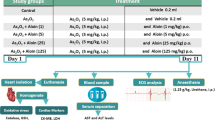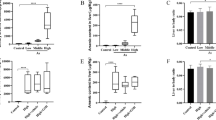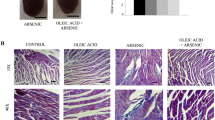Abstract
Arsenic is an environmental contaminant, and accumulating evidence has indicated that exposure to arsenic can cause various diseases, especially cardiotoxicity. Selenium (Se) exerts a vital role in the regulation of multiple physiological activities. Recently, several studies highlighted that Se treatment can effectively antagonize the toxic effects induced by arsenic. However, the exact underlying effect and mechanism of Se on Arsenic-induced cardiotoxicity has not been explored. In the current study, the arsenic trioxide (ATO)-triggered heart damage mice model was used to explore whether Se exerts protective roles in ATO-related cardiotoxicity and its potential mechanism. Our data showed that Se treatment significantly alleviated ATO-mediated cardiotoxicity evidenced by increased weight, decreased myocardial damage markers, and improved heart functions in mice. Furthermore, we demonstrated that Se remarkably inhibited ATO-mediated oxidative stress and inflammatory responses in heart tissues. Mechanistically, we showed that Se upregulated the levels of NAD+ in cardiomyocytes of the mice challenged by ATO, and this effect involved in the activation of the NAD+ biosynthesis through the salvage pathway. Collectively, our findings demonstrated that Se protected against ATO-mediated cardiotoxicity by antioxidant and anti-inflammatory effects via increasing the NAD+ pool in mice.







Similar content being viewed by others
Data Availability
The datasets generated during and/or analyzed during the current study are available from the corresponding author on reasonable request.
Abbreviations
- ATO:
-
Arsenic trioxide
- Se:
-
Selenium
- NAD + :
-
Nicotinamide adenine dinucleotide
- CK:
-
Creatine kinase isoenzymes
- LDH:
-
Lactate dehydrogenase
- GSH:
-
Glutathione
- cTnT:
-
Cardiac isoform of Troponin T
- MDA:
-
Malondialdehyde
- SOD:
-
Superoxide dismutase
- CAT:
-
Catalase
- IL-1β :
-
Interleukin 1β
- IL-6:
-
Interleukin 6
- TNF-α :
-
Tumor necrosis factor-α
- EF:
-
Ejection fraction
- NAMPT:
-
Nicotinamide phosphoribosyltransferase
- IDO:
-
Indoleamine 2,3-dioxygenases
- NADS:
-
Nicotinamide adenine dinucleotide synthase
- NMNAT :
-
Nicotinamide/nicotinic acid mononucleotide adenylyltransferase
References
Wang J, Hu W, Yang H, Chen F, Shu Y, Zhang G, Liu J, Liu Y, Li H, Guo L (2020) Arsenic concentrations, diversity and co-occurrence patterns of bacterial and fungal communities in the feces of mice under sub-chronic arsenic exposure through food. Environ Int 138:105600. https://doi.org/10.1016/j.envint.2020.105600
Jomova K, Jenisova Z, Feszterova M, Baros S, Liska J, Hudecova D, Rhodes CJ, Valko M (2011) Arsenic: toxicity, oxidative stress and human disease. J Appl Toxicol 31:95–107. https://doi.org/10.1002/jat.1649
James KA, Byers T, Hokanson JE, Meliker JR, Zerbe GO, Marshall JA (2015) Association between lifetime exposure to inorganic arsenic in drinking water and coronary heart disease in Colorado residents. Environ Health Perspect 123:128–134. https://doi.org/10.1289/ehp.1307839
Nigra AE, Moon KA, Jones MR, Sanchez TR, Navas-Acien A (2021) Urinary arsenic and heart disease mortality in NHANES 2003–2014. Environ Res 200:111387. https://doi.org/10.1016/j.envres.2021.111387
Alamolhodaei NS, Shirani K, Karimi G (2015) Arsenic cardiotoxicity: an overview. Environ Toxicol Pharmacol 40:1005–1014. https://doi.org/10.1016/j.etap.2015.08.030
Xu M, Rui D, Yan Y, Xu S, Niu Q, Feng G, Wang Y, Li S, Jing M (2017) Oxidative damage induced by arsenic in mice or rats: a systematic review and meta-analysis. Biol Trace Elem Res 176:154–175. https://doi.org/10.1007/s12011-016-0810-4
Ojeda ML, Nogales F, Del Carmen G-L, Carreras O (2022) Binge drinking during the adolescence period causes oxidative damage-induced cardiometabolic disorders: a possible ameliorative approach with selenium supplementation. Life Sci 301:120618. https://doi.org/10.1016/j.lfs.2022.120618
Kielczykowska M, Kocot J, Pazdzior M, Musik I (2018) Selenium - a fascinating antioxidant of protective properties. Adv Clin Exp Med 27:245–255. https://doi.org/10.17219/acem/67222
Bomer N, Grote Beverborg N, Hoes MF, Streng KW, Vermeer M, Dokter MM, IJ J, Anker SD, Cleland JGF, Hillege HL, Lang CC, Ng LL, Samani NJ, Tromp J, van Veldhuisen DJ, Touw DJ, Voors AA, van der Meer P (2020) Selenium and outcome in heart failure. Eur J Heart Fail 22:1415–1423. https://doi.org/10.1002/ejhf.1644
Wang X, Yang B, Cao HL, Wang RY, Lu ZY, Chi RF, Li B (2021) Selenium supplementation protects against lipopolysaccharide-induced heart injury via sting pathway in mice. Biol Trace Elem Res 199:1885–1892. https://doi.org/10.1007/s12011-020-02295-5
Yang HB, Lu ZY, Yuan W, Li WD, Mao S (2022) Selenium attenuates doxorubicin-induced cardiotoxicity through Nrf2-NLRP3 pathway. Biol Trace Elem Res 200:2848–2856. https://doi.org/10.1007/s12011-021-02891-z
Ren Z, Wu Q, Deng H, Yu Y, Tang W, Deng Y, Zhu L, Wang Y, Deng J (2021) Effects of selenium on the immunotoxicity of subacute arsenic poisoning in chickens. Biol Trace Elem Res 199:4260–4272. https://doi.org/10.1007/s12011-020-02558-1
Adedara IA, Fabunmi AT, Ayenitaju FC, Atanda OE, Adebowale AA, Ajayi BO, Owoeye O, Rocha JBT, Farombi EO (2020) Neuroprotective mechanisms of selenium against arsenic-induced behavioral impairments in rats. Neurotoxicology 76:99–110. https://doi.org/10.1016/j.neuro.2019.10.009
Ren Z, Deng H, Deng Y, Tang W, Wu Q, Zuo Z, Cui H, Hu Y, Yu S, Xu SY, Deng J (2021) Effects of selenium on arsenic-induced liver lesions in broilers. Biol Trace Elem Res 199:1080–1089. https://doi.org/10.1007/s12011-020-02222-8
Galli U, Colombo G, Travelli C, Tron GC, Genazzani AA, Grolla AA (2020) Recent advances in NAMPT inhibitors: a novel immunotherapic strategy. Front Pharmacol 11:656. https://doi.org/10.3389/fphar.2020.00656
Garten A, Schuster S, Penke M, Gorski T, de Giorgis T, Kiess W (2015) Physiological and pathophysiological roles of NAMPT and NAD metabolism. Nat Rev Endocrinol 11:535–546. https://doi.org/10.1038/nrendo.2015.117
Zhou CC, Yang X, Hua X, Liu J, Fan MB, Li GQ, Song J, Xu TY, Li ZY, Guan YF, Wang P, Miao CY (2016) Hepatic NAD(+) deficiency as a therapeutic target for non-alcoholic fatty liver disease in ageing. Br J Pharmacol 173:2352–2368. https://doi.org/10.1111/bph.13513
Zhou B, Wang DD, Qiu Y, Airhart S, Liu Y, Stempien-Otero A, O’Brien KD, Tian R (2020) Boosting NAD level suppresses inflammatory activation of PBMCs in heart failure. J Clin Invest 130:6054–6063. https://doi.org/10.1172/JCI138538
Li, L, Xu W, Zhang L (2021) KLF15 Regulates oxidative stress response in cardiomyocytes through NAD(). Metabolites 11 https://doi.org/10.3390/metabo11090620
Zheng D, Zhang Y, Zheng M, Cao T, Wang G, Zhang L, Ni R, Brockman J, Zhong H, Fan GC, Peng T (2019) Nicotinamide riboside promotes autolysosome clearance in preventing doxorubicin-induced cardiotoxicity. Clin Sci (Lond) 133:1505–1521. https://doi.org/10.1042/CS20181022
Wang XY, Wang JZ, Gao L, Zhang FY, Wang Q, Liu KJ, Xiang B (2017) Inhibition of nicotinamide phosphoribosyltransferase and depletion of nicotinamide adenine dinucleotide contribute to arsenic trioxide suppression of oral squamous cell carcinoma. Toxicol Appl Pharmacol 331:54–61. https://doi.org/10.1016/j.taap.2017.05.008
Zheng B, Yang Y, Li J, Li J, Zuo S, Chu X, Xu S, Ma D, Chu L (2021) Magnesium isoglycyrrhizinate alleviates arsenic trioxide-induced cardiotoxicity: contribution of Nrf2 and TLR4/NF-kappaB signaling pathway. Drug Des Devel Ther 15:543–556. https://doi.org/10.2147/DDDT.S296405
Messarah M, Klibet F, Boumendjel A, Abdennour C, Bouzerna N, Boulakoud MS, El Feki A (2012) Hepatoprotective role and antioxidant capacity of selenium on arsenic-induced liver injury in rats. Exp Toxicol Pathol 64:167–174. https://doi.org/10.1016/j.etp.2010.08.002
Chen YC, Lin-Shiau SY, Lin JK (1998) Involvement of reactive oxygen species and caspase 3 activation in arsenite-induced apoptosis. J Cell Physiol 177:324–333. https://doi.org/10.1002/(SICI)1097-4652(199811)177:2%3c324::AID-JCP14%3e3.0.CO;2-9
Liang Y, Zheng B, Li J, Shi J, Chu L, Han X, Chu X, Zhang X, Zhang J (2020) Crocin ameliorates arsenic trioxideinduced cardiotoxicity via Keap1-Nrf2/HO-1 pathway: reducing oxidative stress, inflammation, and apoptosis. Biomed Pharmacother 131:110713. https://doi.org/10.1016/j.biopha.2020.110713
Sun TL, Liu Z, Qi ZJ, Huang YP, Gao XQ, Zhang YY (2016) (-)-Epigallocatechin-3-gallate (EGCG) attenuates arsenic-induced cardiotoxicity in rats. Food Chem Toxicol 93:102–110. https://doi.org/10.1016/j.fct.2016.05.004
Breton M, Costemale-Lacoste JF, Li Z, Lafuente-Lafuente C, Belmin J, Mericskay M (2020) Blood NAD levels are reduced in very old patients hospitalized for heart failure. Exp Gerontol 139:111051. https://doi.org/10.1016/j.exger.2020.111051
Abdellatif M, Sedej S, Kroemer G (2021) NAD(+) Metabolism in cardiac health, Aging, and Disease. Circulation 144:1795–1817. https://doi.org/10.1161/CIRCULATIONAHA.121.056589
Chiao YA, Chakraborty AD, Light CM, Tian R, Sadoshima J, Shi X, Gu H, Lee CF (2021) NAD(+) redox imbalance in the heart exacerbates diabetic cardiomyopathy. Circ Heart Fail 14:e008170. https://doi.org/10.1161/CIRCHEARTFAILURE.120.008170
Khadka D, Kim HJ, Oh GS, Shen A, Lee S, Lee SB, Sharma S, Kim SY, Pandit A, Choe SK, Kwak TH, Yang SH, Sim H, Eom GH, Park R, So HS (2018) Augmentation of NAD(+) levels by enzymatic action of NAD(P)H quinone oxidoreductase 1 attenuates adriamycin-induced cardiac dysfunction in mice. J Mol Cell Cardiol 124:45–57. https://doi.org/10.1016/j.yjmcc.2018.10.001
Tong D, Schiattarella GG, Jiang N, Altamirano F, Szweda PA, Elnwasany A, Lee DI, Yoo H, Kass DA, Szweda LI, Lavandero S, Verdin E, Gillette TG, Hill JA (2021) NAD(+) repletion reverses heart failure with preserved ejection fraction. Circ Res 128:1629–1641. https://doi.org/10.1161/CIRCRESAHA.120.317046
Feng, D, Xu D, Murakoshi N, Tajiri K, Qin R, Yonebayashi S, Okabe Y, Li S, Yuan Z, Aonuma K, Ieda M (2020) Nicotinamide phosphoribosyltransferase (Nampt)/nicotinamide adenine dinucleotide (NAD) axis suppresses atrial fibrillation by modulating the calcium handling pathway. Int J Mol Sci 21 https://doi.org/10.3390/ijms21134655
Oka SI, Byun J, Huang CY, Imai N, Ralda G, Zhai P, Xu X, Kashyap S, Warren JS, Alan Maschek J, Tippetts TS, Tong M, Venkatesh S, Ikeda Y, Mizushima W, Kashihara T, Sadoshima J (2021) Nampt potentiates antioxidant defense in diabetic cardiomyopathy. Circ Res 129:114–130. https://doi.org/10.1161/CIRCRESAHA.120.317943
Funding
This work was supported by The Program of Yingshang ChengDong Hospital (201903127).
Author information
Authors and Affiliations
Contributions
Hai-Bing Yang provided funding and designed research; Hai-Bing Yang and Wei Yuan performed experiments; Hai-Bing Yang and Wei Yuan analyzed data and wrote the manuscript; Shang Mao checked the manuscript. All authors contributed with productive discussions and knowledge to the final version of this manuscript.
Corresponding author
Ethics declarations
Conflict of Interest
The authors declare no competing interests.
Additional information
Publisher's Note
Springer Nature remains neutral with regard to jurisdictional claims in published maps and institutional affiliations.
Supplementary Information
Below is the link to the electronic supplementary material.
Rights and permissions
Springer Nature or its licensor (e.g. a society or other partner) holds exclusive rights to this article under a publishing agreement with the author(s) or other rightsholder(s); author self-archiving of the accepted manuscript version of this article is solely governed by the terms of such publishing agreement and applicable law.
About this article
Cite this article
Yang, HB., Yuan, W., Li, WD. et al. Selenium Supplementation Protects Against Arsenic-Trioxide-Induced Cardiotoxicity Via Reducing Oxidative Stress and Inflammation Through Increasing NAD+ Pool. Biol Trace Elem Res 201, 3941–3950 (2023). https://doi.org/10.1007/s12011-022-03478-y
Received:
Accepted:
Published:
Issue Date:
DOI: https://doi.org/10.1007/s12011-022-03478-y




